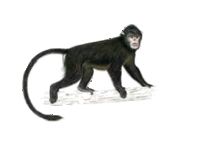Burmese snub-nosed monkey
| Burmese snub-nosed monkey | ||||||||||||
|---|---|---|---|---|---|---|---|---|---|---|---|---|

Burmese snub-nosed monkey ( Rhinopithecus strykeri ) |
||||||||||||
| Systematics | ||||||||||||
|
||||||||||||
| Scientific name | ||||||||||||
| Rhinopithecus strykeri | ||||||||||||
| Geissmann et al., 2010 |
The Burmesische snub-nosed ( Rhinopithecus strykeri ) is a primate species from the group of Slim monkeys (Presbytini). The species was only discovered and described in 2010 by a team of scientists led by Thomas Geissmann from the Anthropological Institute of the University of Zurich . It was named in honor of Jon Stryker, president and founder of the Arcus Foundation, which supports the research.
features
The species has an almost completely black fur, white tufts of ears, a white goatee and a white dam . The face is bare, the skin of the face is pink. Their tail is long and reaches 140 percent of the length of the head and torso . The lips are pronounced, the nostrils directed upwards at an angle. In the language of the local population they are known as mey nwoah , "monkey with a raised nose".
The Burmese snub-nosed monkey reaches a head body length of about 55 cm and a tail length of 68 to 78 cm. Females are about 8.5 kg lighter than males who weigh about 14 kg. In addition to the goatee, there is a white mustache.
distribution and habitat
The Burmese snub-nosed monkey lives in the mountainous forests of the Gaoligong Shan in the northeast of the Kachin State , the northernmost state of Myanmar (Burma). A small population of around 70 animals lives in northwest China's Yunnan Province. The area populated by the species is only about 270 square kilometers, lies at an altitude of 1700 to 3200 meters above sea level and is geographically cut off from the range of other snub-nosed monkeys by the Mekong , the Saluen and high mountain ranges. According to the statements of local hunters, the monkeys spend the summer between May and October in higher regions in mixed forests with moderate temperatures. In the winter months, when snow falls and the food supply becomes scarce, they come closer to human settlements. The total population of the species consists of only 950 individuals. The Burmese snub-nosed monkey must therefore be viewed as critically endangered.
behavior
According to local hunters, Burmese snub-nosed monkeys run into their noses when it rains and the animals free themselves by sneezing. The monkeys supposedly spend rainy days sitting with their heads between their knees. These reports have not yet been scientifically confirmed.
Various specimens have been seen eating bamboo shoots.
literature
- Thomas Geissmann et al .: A new species of Snub-nosed monkey, Genus Rhinopithecus Milne-Edwards, 1872 (Primates, Colobinae), from northern Kachin State, northeastern Myanmar. In: American Journal of Primatology. 72, 2010, ISSN 0275-2565 , pp. 1–12, doi : 10.1002 / ajp.20894 .
Individual evidence
- ^ A b Rowe & Myers (eds.): All the World's Primates . Pogonias Press, Charlestown 2016, ISBN 978-1-940496-06-1 , pp. 627-628 .
- ↑ a b Yin Yang, Ying-Ping Tian, Chen-Xiang He, Zhipang Huang, Shao-Hua Dong, Bin Wang, Guang-Song Li, Zuo-Fu Xiang, Yong-Cheng Long and Wen Xiao. 2016. The Critically Endangered Myanmar Snub-nosed Monkey Rhinopithecus strykeri found in the Salween River Basin, China. Oryx, November 2016. DOI: 10.1017 / S0030605316000934
Web links
- Beat Müller: New snub-nosed monkey discovered in Myanmar. In: Information Service Science. October 27, 2010.
- Newly discovered snub-nosed monkey sneezes in the rain. In: ScienceDaily. October 27, 2010 (English).
- Rhinopithecus strykeri inthe IUCN 2013 Red List of Threatened Species . Posted by: Geissmann, T., Momberg, F. & Whitten, T., 2012. Retrieved December 29, 2013.